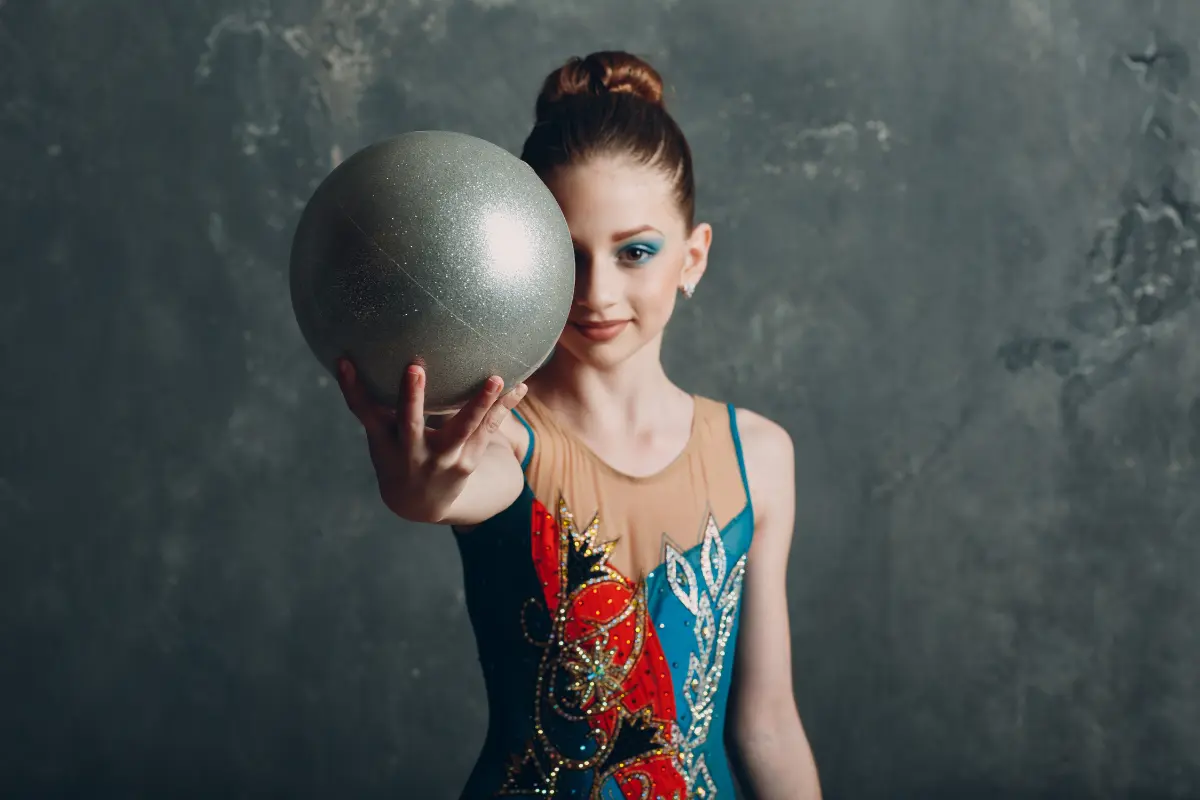Rhythmic gymnastics is one of those sports that looks almost like magic. A gymnast twirls across the floor, tossing a ribbon high into the air or spinning a hoop around her ankles with perfect timing—all choreographed to music. But behind that elegance is a highly structured sport with detailed rules and a tough scoring system.
Contents
What Exactly Is Rhythmic Gymnastics?
In rhythmic gymnastics (often shortened to RG), athletes perform routines on a 13m x 13m carpet, always using an apparatus: ribbon, ball, hoop, clubs, or (in junior levels) rope. Unlike artistic gymnastics, you won’t see tumbling or vaults here. Instead, it’s all about balance, leaps, turns, and creative handling of the apparatus.
Each routine is set to music from start to finish. The gymnast has to stay in sync with it, building an expressive story through movement and flow.
The Structure of Rhythmic Gymnastics
Rhythmic gymnastics events are primarily divided into two categories: Individual and Group routines. Both categories require athletes to manipulate different apparatus, perform dance elements, and demonstrate impressive technical skills.
| Division | Gymnasts on Floor | Apparatus Used | Routine Length |
|---|---|---|---|
| Individual | 1 | Hoop, Ball, Clubs, Ribbon | 1:15 – 1:30 |
| Group | 5 (+1 reserve) | 5 x same or 3+2 combo | 2:15 – 2:30 |
1. Individual Rhythmic Gymnastics
In individual rhythmic gymnastics, gymnasts perform a routine using one of the following apparatus:
- Ball
- Ribbon
- Hoop
- Clubs
Each gymnast competes individually, and their performance is evaluated based on a set of specific criteria related to technical execution, artistic expression, and the difficulty of their apparatus handling.
2. Group Rhythmic Gymnastics
Group rhythmic gymnastics involves teams of five gymnasts performing a synchronized routine. This category allows for more complex teamwork, with the athletes handling multiple apparatus simultaneously, often performing intricate exchanges and throws. The group category also uses the same apparatus as the individual events, but the performance focuses on timing, coordination, and group synchronization.
Why no rope for seniors?
Rope left the senior FIG programme after Tokyo 2021, but it remains compulsory for juniors and often shows up in galas. The Technical Committee could vote it back in a future cycle.
How Are Competitions Structured?
Rhythmic gymnastics competitions typically follow a multi-stage format that tests a gymnast’s consistency, range of skills, and ability to perform under pressure. These events can stretch over multiple days and include both individual and group divisions.
All-Around Qualification
This is the entry point to any major competition. Each gymnast (or group) performs one routine with each scheduled apparatus. For individuals, that means one routine each with hoop, ball, clubs, and ribbon. For groups, it means two different routines—usually one with five of the same apparatus and one with a 3+2 split (like three balls and two ribbons).
The goal in qualifications? Accumulate the highest possible combined score. The top-ranking gymnasts move forward to the finals.
Apparatus Finals
In these finals, it’s all about specializing. Only the eight best-scoring athletes on each apparatus from qualification are allowed to compete again. These routines tend to be more daring, since gymnasts can go all-out on their strongest apparatus.
Judges score each performance independently, so a gymnast might medal in clubs, for example, but not in ball.
Group Finals
The top-scoring groups from qualification also move on to compete again with both their apparatus routines. The best combined group score earns the group all-around medal, while separate medals are awarded for each group routine type.
Team Ranking
When a country sends a full squad—both individual gymnasts and a group—their combined scores count toward a national team total. This ranking includes the top eight individual routines (across all apparatus and gymnasts) and the scores from both group exercises.
Event Medals
By the end of a major international event like a World Cup, World Championships, or the Olympic Games, medals are awarded in:
- Individual All-Around
- Four Individual Apparatus Finals
- Group All-Around
- Two Group Apparatus Finals
That’s seven medal events total. For fans, it means lots of podium moments. For gymnasts, it’s a marathon of skill, endurance, and artistry.
It’s a lot of sparkle, a lot of score sheets—and a lot of pressure.
The Rules of Rhythmic Gymnastics
Rhythmic gymnastics runs on precision—not just in movement, but also in how routines are timed, composed, and judged. The sport operates under the watchful eye of the Fédération Internationale de Gymnastique (FIG), which outlines everything from how long a routine should last to what deductions apply for a tangled ribbon.
Routine Lengths
- Individual routines must last between 1 minute 15 seconds and 1 minute 30 seconds. These routines feature one gymnast using a single apparatus.
- Group routines are performed by five gymnasts (plus a reserve) and must be between 2 minutes 15 seconds and 2 minutes 30 seconds.
Routines are timed to the second. Going over or under—even slightly—will result in a time penalty: 0.05 points for each full second outside the legal window.
Judges also expect the routine to end precisely with the music. If a gymnast finishes too early or late, it can trigger a music mismatch deduction of 0.30.
Each competition cycle includes designated apparatus per year, and gymnasts prepare routines based on that schedule. The apparatus lineup changes every year to test all-around skills over time.
Apparatus handling also follows strict criteria. For example:
- The ribbon must move continuously—if it pauses or tangles, deductions are automatic.
- Clubs must be used symmetrically and caught cleanly.
- Rolls, throws, and catches must meet height and rotation standards to earn difficulty credit.
Finally, gymnasts must perform barefoot, and costumes must allow free movement while staying modest and in line with FIG’s aesthetic standards.
How Is the Score Calculated?
Rhythmic gymnastics scoring might seem mysterious at first, but it follows a detailed and structured system that judges three core elements of a performance: difficulty, artistry, and execution. Here’s how each panel works:
D Panel – Difficulty (Open-Ended)
This panel has no cap on points. Judges tally up points for:
- Body Difficulties: Leaps, balances, and pirouettes, each requiring specific form and technique.
- Apparatus Difficulties: Throws and catches, rolls, and complex handling elements that demand control and coordination.
- Dynamic Elements with Rotation (R): Tosses combined with multiple body rotations (like flips or pivots) before catching the apparatus.
Each move must meet the strict requirements listed in the Code of Points to be credited. Repetition, incomplete technique, or unclear execution may result in elements being denied.
A Panel – Artistry (Max 10.0)
The A Panel evaluates the performance’s expression, structure, and harmony with music:
- Does the routine match the music in mood and timing?
- Is the choreography creative and original?
- Does the gymnast use the full floor space effectively?
- Are transitions smooth and rhythmically consistent?
Poor musical interpretation, lack of variety, or awkward transitions can bring this score down quickly.
E Panel – Execution (Max 10.0)
This panel watches every detail of how movements are performed:
- Is the gymnast’s posture clean and aligned?
- Are the apparatus catches smooth and secure?
- Are the feet pointed, legs extended, and landings controlled?
Mistakes such as bent knees, shaky balances, or awkward apparatus handling all lead to deductions.
Scoring Process
Each panel has four judges. The highest and lowest scores are thrown out. The remaining two are averaged, ensuring a more balanced result. Then, judges apply penalties—these can come from:
- Time faults (routine too short or long)
- Stepping out of bounds
- Apparatus drops or tangles
- Finishing late or off-music
Final Score Formula:
Final Score = D (open) + A (max 10.0) + E (max 10.0) – Penalties
What Does a Winning Score Look Like?
At the elite level, difficulty scores often go beyond 15.0. That means even with a perfect 10.0 in both artistry and execution, top scores may land in the mid-to-high 30s.
In group routines, additional collaboration bonuses and increased risk can push scores above 40.0. These high marks reflect not just technical skill, but deep trust and synchronization between teammates.
Why It Looks Easy (But Really Isn’t)
Here’s the truth: rhythmic gymnastics is incredibly hard. The routines are smooth and beautiful on the surface, but behind them is a mountain of technical detail.
If a ball slips by even half a second, or the ribbon catches air wrong, the gymnast might drop from gold medal to tenth place. But when everything works—the music, the movement, the precision—you get those unforgettable, mesmerizing moments that make rhythmic gymnastics so special.













